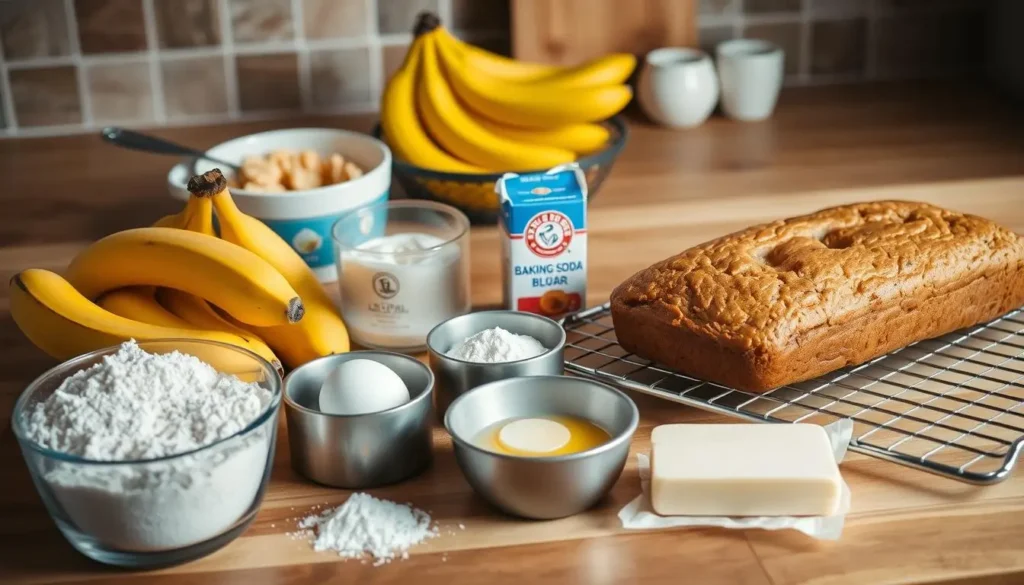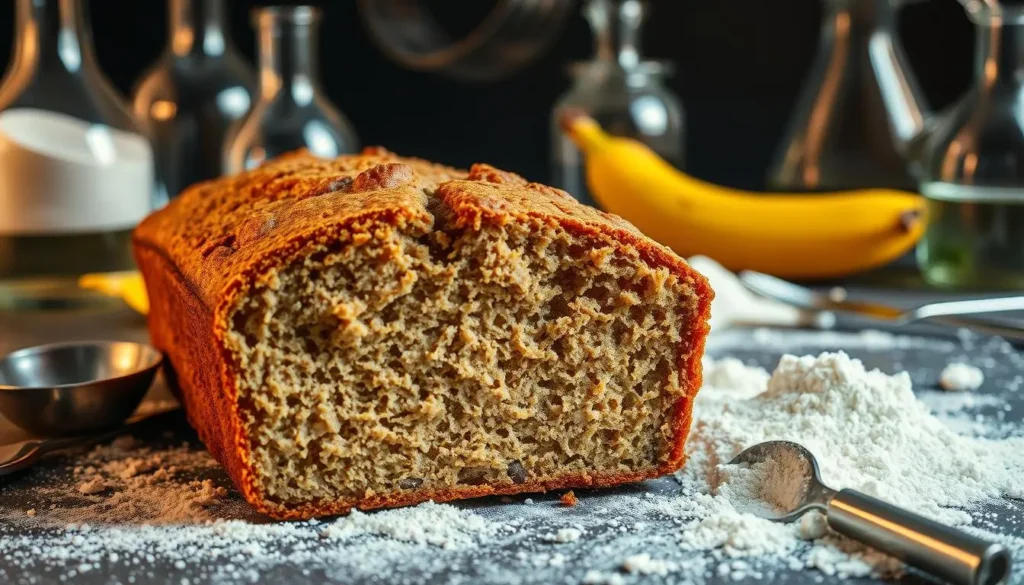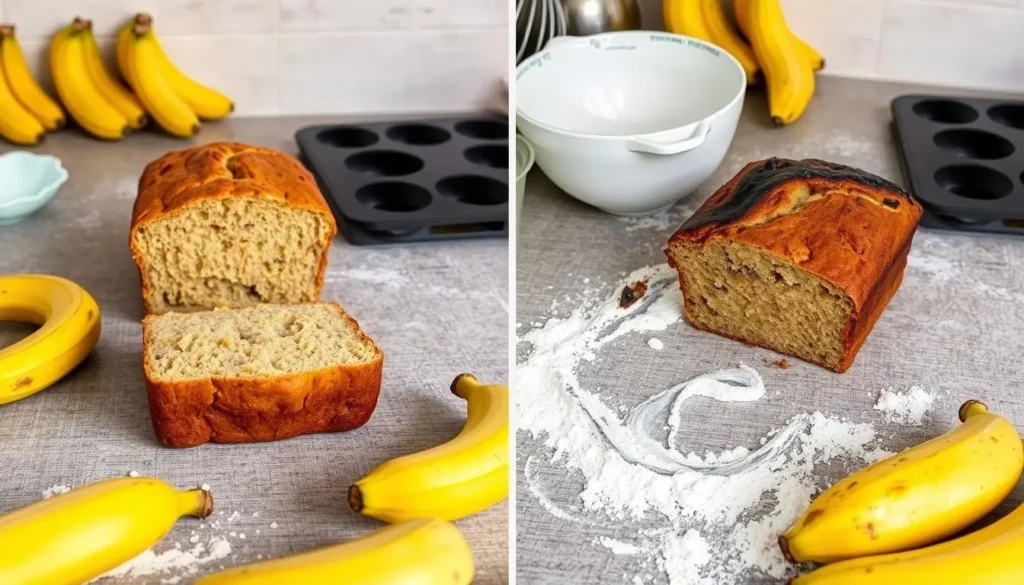When baking banana bread, you aim for it to be moist and full of flavor. But, what’s the biggest mistake that can mess up your loaf?
Even with many banana bread recipes, your loaf might not turn out perfectly. To achieve perfection, you need to understand the science and avoid common mistakes. This article will reveal the key mistake to avoid and provide tips to make your banana bread amazing.
Key Takeaways
- Avoiding the number one mistake when making banana bread is crucial for a moist and flavorful loaf
- Understanding the science behind perfect banana bread is essential for achieving high-quality results
- Using the right techniques and ingredients can elevate your banana bread game
- Avoiding common pitfalls is key to creating a delicious banana bread recipe
- What is the number one mistake made when making banana bread will be revealed in this article
- Learning from common mistakes can help you create a perfect banana bread recipe

Understanding the Science Behind Perfect Banana Bread
To make the perfect banana bread, you need to know the basics of banana bread science. It’s all about the moisture, as it affects the bread’s texture. To get a tender crumb, adjust the liquid in your recipe or soak bananas in liquid.
Chemical reactions, like the Maillard reaction, are key for flavor and browning. This reaction happens when the bread bakes, creating new flavors and colors. Keeping an eye on temperature is also important, as it influences these reactions and the bread’s texture.
- Moisture levels: Controlling moisture in banana bread is crucial to achieving the right texture.
- Chemical reactions: Understanding chemical reactions in baking, such as the Maillard reaction, can help you optimize flavor and browning.
- Temperature control: Temperature control is essential to achieving the perfect texture and flavor in banana bread.
By understanding these basic principles, you can tweak your recipe and techniques for the best banana bread. Knowing the science behind banana bread helps you make a moist and flavorful loaf every time.
What is the Number One Mistake Made When Making Banana Bread
Baking banana bread can be tricky. One big mistake is overmixing the batter. This makes the bread dense and tough. It happens when you mix too much or use the wrong flour.
To fix this, mix wet and dry ingredients separately. Then, gently fold them together. Use the right flour, like all-purpose or bread flour, and avoid overmixing.
Signs of overmixing include a smooth, shiny batter. If it’s overmixed, the bread won’t be light and fluffy. It will be dense instead. To avoid this, mix gently and don’t overbeat the batter.
By following these tips, you can make delicious banana bread. Use quality ingredients, mix gently, and bake at the right temperature. With practice, you’ll make perfect banana bread every time.
Selecting and Preparing Your Bananas
Choosing the right bananas is key for tasty banana bread. Look for bananas that are soft to the touch and have brown spots. Selecting bananas for banana bread greatly impacts the flavor and texture.
To figure out how many cups of banana 2 bananas make, use a simple guide. 2 medium bananas usually mash up to 1 cup. But, banana sizes can vary, so measuring is best to get the right amount.
Ideal Ripeness Level
The perfect banana for banana bread is slightly soft and has brown spots. This ensures they’re sweet and easy to mash. Too green bananas are not sweet enough, and too ripe ones are mushy.
Proper Mashing Techniques
Mashing bananas right is crucial for banana bread. You want them smooth but still a bit textured. This makes the bread moist and tasty.
Storage Tips for Ripening Bananas
To ripen bananas, keep them at room temperature, away from sunlight. You can also speed up ripening by putting them in a paper bag with an apple or avocado. These fruits release ethylene gas, helping ripen the bananas.
Essential Measurements for Banana Bread Success
Measuring ingredients for banana bread is crucial for a delicious result. The right amounts ensure the perfect mix of flavors and textures. Knowing how many cups of banana to use is key, as it affects the bread’s texture and taste.
To achieve the best banana bread, accurate measurements are essential. Measuring ingredients for banana bread is more than just following a recipe. It’s about ensuring the bread turns out right. A recipe using 2 bananas will make a moist and tasty bread, if done correctly.
- Use a digital kitchen scale to measure ingredients by weight
- Use measuring cups to measure ingredients by volume
- Make sure to level off ingredients when using measuring cups
By following these tips and using the right measurements, you’ll make a delicious banana bread every time. Remember, measuring ingredients is a crucial step to making a perfect loaf. So, don’t skip it!
Choosing the Right Oil for Your Banana Bread
Choosing the right oil is key to making great banana bread. You might wonder what oil is best for banana bread. Each oil has its own taste and texture, making some better for certain breads.
Popular oils for banana bread include vegetable oil, coconut oil, and olive oil. Vegetable oil is neutral-tasting and works well in most recipes. Coconut oil adds a unique flavor and makes the bread moist. Olive oil has a strong taste and is best mixed with other oils.
Comparing Different Oil Options
- Vegetable oil: neutral flavor, works well in most recipes
- Coconut oil: distinct flavor, creates a moist and tender crumb
- Olive oil: strong flavor, best used in combination with other oils
Understanding oil’s role in banana bread helps you choose the best one. This choice can make your banana bread stand out. Whether you want a classic taste or something new, picking the right oil is crucial.
| Oil Option | Flavor Profile | Texture |
|---|---|---|
| Vegetable Oil | Neutral | Light and fluffy |
| Coconut Oil | Distinct | Moist and tender |
| Olive Oil | Strong | Rich and dense |
Working with Limited Banana Supply
Ever wanted banana bread but didn’t have enough bananas? You might ask what can i use if i don’t have enough bananas for banana bread. While nothing perfectly replaces bananas, some ingredients can make a tasty treat. Applesauce and mashed avocado are great for adding moisture and flavor.
Here are some options you can consider:
- Applesauce: adds natural sweetness and moisture
- Mashed avocado: contributes healthy fats and creamy texture
- Pureed pumpkin: provides moisture and a hint of spice
Using these substitutes will change your banana bread’s taste. To make the most of your bananas, try reducing the recipe or mix bananas with other fruits. This way, you can still enjoy a delicious banana bread.
Remember, the secret to success is trying new things and being flexible. Don’t hesitate to mix and match ingredients. With a bit of creativity, you can make a tasty banana bread even with fewer bananas.
| Substitute | Benefits | Effects on Flavor and Texture |
|---|---|---|
| Applesauce | adds moisture and natural sweetness | softer texture, sweeter flavor |
| Mashed Avocado | contributes healthy fats and creamy texture | denser texture, nuttier flavor |
Mixing Methods That Make a Difference
When making banana bread, how you mix matters a lot. It changes the loaf’s texture and taste. You want it to be soft and taste great. Mixing wet and dry ingredients separately is key.

This method stops overmixing. It makes sure each ingredient is mixed well before combining. This leads to a consistent texture and flavor.
- Use a gentle folding technique to combine the wet and dry ingredients.
- Avoid overmixing the batter, as this can lead to a dense and tough loaf.
- Make sure to mix the wet ingredients, such as eggs and sugar, until they are well combined and smooth.
- Similarly, mix the dry ingredients, such as flour and spices, until they are well incorporated.
By following these tips and using the right mixing methods for banana bread, you can create a delicious and moist loaf. Remember to balance your wet ingredients vs. dry ingredients for the best results.
| Ingredient | Quantity | Mixing Method |
|---|---|---|
| Flour | 2 cups | Dry ingredients |
| Sugar | 1 cup | Wet ingredients |
| Eggs | 2 | Wet ingredients |
Baking Temperature and Timing Secrets
Getting the temperature and timing right is key when baking banana bread. The best temperature is between 325°F and 350°F, depending on your oven and loaf size. To check if it’s done, insert a toothpick into the center. If it comes out clean, it’s ready.
To bake a perfect loaf, consider the oven position. Place it in the center for even cooking. Using a thermometer ensures your oven is at the right temperature. These steps will help you make a delicious banana bread with a soft crumb.
Oven Position Guidelines
- Place your banana bread in the center of the oven to ensure even cooking.
- Use a thermometer to check the oven temperature and adjust as needed.
- Avoid opening the oven door too often, as this can cause the temperature to fluctuate.
Testing for Doneness
Testing for doneness is crucial in baking banana bread. Use a toothpick or cake tester to check if it’s cooked. If unsure, check the internal temperature, which should be 200°F to 210°F. These tips will help you bake a banana bread that impresses everyone.
Troubleshooting Common Banana Bread Problems
When baking banana bread, you might face some common issues. These can mess up the texture, taste, or quality of your loaf. Troubleshooting banana bread problems means knowing what causes them and how to fix them. By avoiding these common mistakes, you can make a tasty banana bread every time.
Some common banana bread problems include a dense texture, not enough flavor, or it gets overcooked. Here are some tips to help you fix these issues:
- Double-check your ingredient measurements for accuracy.
- Choose the right flour and leavening agents.
- Avoid overmixing the batter to prevent a dense crumb.
By following these tips and being aware of common banana bread problems, you can troubleshoot banana bread issues. Remember, practice makes perfect. With time, you’ll get better at making delicious banana bread.
For more help on fixing common banana bread problems, look at a trusted recipe book or online resources. Happy baking!
| Common Problem | Cause | Solution |
|---|---|---|
| Dense Crumb | Overmixing or incorrect flour ratio | Check ingredient measurements and mix batter gently |
| Lack of Flavor | Insufficient spices or vanilla extract | Adjust spice and vanilla extract quantities to taste |
| Overcooking | Incorrect oven temperature or baking time | Check oven temperature and adjust baking time as needed |
Conclusion: Mastering Your Banana Bread Game

Making the perfect banana bread takes patience and practice. Follow the tips and techniques from this article to improve your skills. Whether you’re new or experienced, these insights will help you make a delicious treat.
With dedication, you’ll get your banana bread recipe just right. Focus on the right measurements, mixing, and baking temperatures. Avoiding common mistakes and understanding the science behind banana bread will help you create a masterpiece.
So, get ready to bake your way to banana bread perfection. With the knowledge from this article, you’re on your way to becoming a banana bread expert. You’ll impress and delight everyone with your homemade creations.
FAQ
What is the number one mistake made when making banana bread?
Overmixing the batter is a common mistake in banana bread making. It can make the bread dense and tough. To avoid this, mix gently and use the right flour.
How do I select and prepare the perfect bananas for banana bread?
The right bananas are key for great banana bread. Look for bananas that are slightly soft and have brown spots. Mashing them right releases their sweetness and flavor. Store bananas at room temperature to ripen them.
How many cups of banana are 2 bananas?
Knowing the right banana measurement is crucial. Two bananas usually equal about 1 cup of mashed banana. Accurate measurements and techniques ensure a delicious banana bread every time.
What is the best oil to use when making banana bread?
The oil you choose affects the bread’s texture and taste. Compare oils like vegetable, coconut, and olive to find the best for your recipe. Each oil has its own flavor and texture. Using healthier oils can make your banana bread guilt-free yet delicious.
What can I use if I don’t have enough bananas for my banana bread recipe?
If you’re short on bananas, consider substitutes like applesauce or mashed avocado. They add moisture and flavor, but change the bread’s character. Adjusting your recipe can still yield a tasty banana bread, even with fewer bananas.

